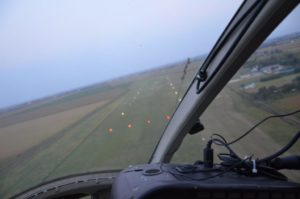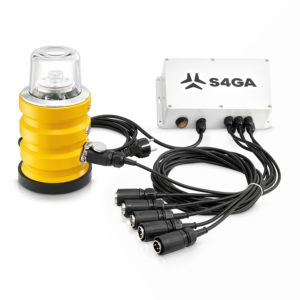



SP-102 portable runway lights are ICAO compliant aviation lights designed to operate in remote areas. LED optics generates correct light output in terms of intensity and chromaticity. SP-102 airfield light is powered by a standard deep-cycle battery which can be stored locally.
For 100% autonomy SP-102 Portable Runway Edge Light can be converted to solar runway light by adding 5W solar panelRead more
| Specification | Parameter | Description |
| Compliance | ICAO, Annex 14 Compliance | Photometric: Par. 5.3.9.9 |
| Chromaticity: Appendix 1, Figure A1-1 | ||
| FAA Compliance | 150/5345-50B | |
| Operating time in steady mode | Min intensity | 25 hrs. |
| Max Intensity | 10 hrs. | |
| Operating modes | Selective via push-button Last selected mode is memorized | Steady-on: Min - Med - Max Intensity |
| Flashing: 30 - 60 - 120 FPM | ||
| Automatic Dusk-Till-Dawn (adjustable intensity) | ||
| NVG Only - for covert operations | ||
| NVG + Visible LED | ||
| Optics | Type | Omnidirectional |
| Colour | White (clear) | |
| Interchangable optical head | Yes | |
| LED | Life span: min 100.000 hrs | |
| Consistent photometrics for product life | ||
| Operating temperature range | Standard | -20 to 50 ºC (-4 to 122 ºF) |
| Arctic pack | -40 to 80 ºC (-40 to 176 ºF) | |
| Battery | Type | Sealed Lead Acid Battery (SLAB) air transport approved |
| Capacity | 4,5 Ah | |
| Nominal voltage (V) | 6,0 V | |
| Life span | 4-5 years / 1.200 cycles | |
| On-board battery indicator | Yes | |
| Battery replacable by user | Yes | |
| Battery Charging | External charging port | Yes |
| Available charging options | via OCT-102 Charger | |
| via solar panel | ||
| Charging time via OCT-102 Charger | 8 hrs | |
| Charging time via solar panel | 12 hrs | |
| Control & Monitoring | Multifuntional Push-button | On-Off, selecting operating mode, reset Protection against incidental activation |
| Automatic Light Control (ALC) | ALC adjusts intensity level if battery reaches low capacity to ensure continued operation | |
| Built-in microprocessor | Yes | |
| Built-in protection against excessive overcharging/discharging of the battery | Yes | |
| Solar Panel | Nominal power output | 5W |
| Installed separately from the lighting unit | Yes | |
| Panel facing direction | Unidirectional for optimal energy collection | |
| Life span | 15 years | |
| Casing | Waterproof rating | IP-65 |
| UV resistant | Yes | |
| Height / Diameter | 210 x 125 mm | |
| Weight (kg) | 2 | |
| Chassis Material | Non-corrosive aluminum | |
| Dome Material (standard) | Glass | |
| Dome Material (optional) | Premium, UV-resistant polycarbonate | |
| CE Compliance | Standards | EN 61000-4-2:2009, |
| EN 61000-4-3:2007/A2:2011 | ||
| PN-EN 61000-4-4:2013-05 | ||
| EN 61000-4-5:2014-10 | ||
| EN 61000-4-6: 2014-04 |
 We tend to associate airports with grand facilities equipped with plenty of amenities and newest technological solutions. But a lot of airports consists just of a single runway, which sometimes can be gravel of grassy. In such cases, runway edge portable lights are used. Let’s have a closer look at them. First of all, we shall establish when exactly portable lighting is used.
We tend to associate airports with grand facilities equipped with plenty of amenities and newest technological solutions. But a lot of airports consists just of a single runway, which sometimes can be gravel of grassy. In such cases, runway edge portable lights are used. Let’s have a closer look at them. First of all, we shall establish when exactly portable lighting is used.
Runway edge portable lights can be used as:
Runway edge lighting, just like any other kind of airport lighting, needs to meet an array of requirements, standards and regulations. Primarily, such lighting must meet the ICAO regulations (International Civil Aviation Organization), Annex 14. Moreover, the compatibility with the FAA regulations (Federal Aviation Agency) is also required. For the members of the European Union, the following standards must be obtained: EN 61000-4-2:2009, EN 61000-4-3:2007/A2:2011, PN-EN 61000-4-4:2013-05, and EN 61000-4-6: 2014-04.
What characteristics should runway edge portable lighting have?
As mentioned before, edge portable lighting can work in different modes. First and foremost, one can adjust the intensity level: minimum, medium and maximum. Moreover, the lights can give out 30, 60 or 120 flashes per minute. Finally, an automatic from-dusk-to-down mode can be chosen.
The work time of a light depends on the light intensity. If the light intensity is minimum, a runway edge portable light will work for 25 hours. If the intensity is set to maximum – 10 hours.
Portable lighting is often exposed to external conditions influences, including temperatures. A standard lighting can work in temperatures from 20°C to 50°C. However, a lamp set that is often called the “Arctic pack” can work in temperatures from -40°C to 80°C.
 Runway edge portable lighting can be powered in three different ways. If possible, it is primarily charged with solar panels. If not, a charging station can also be used. Finally, the lights can be powered by the use of an electric power grid.
Runway edge portable lighting can be powered in three different ways. If possible, it is primarily charged with solar panels. If not, a charging station can also be used. Finally, the lights can be powered by the use of an electric power grid.
What makes the control and monitoring system of runway edge portable lights different? Let’s see: